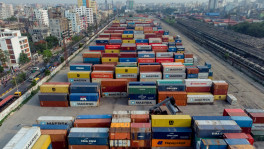Foreign aid pledge up 40.42% in July-April of FY21
Disbursements did not rise much in this period compared to the same period of the last fiscal year

Aid commitment from development partners increased by 40.42% in the first 10 months of the current financial year compared to the same period of the previous fiscal year.
But disbursements did not increase much during this period compared to the same period of the last fiscal year.
The latest data from the Economic Relations Division show $5,275.43 million was pledged by development partners between July and April of the fiscal year 2020-21. Of this, 88.75% was pledged as loans and the rest was grants.
During the same period of the previous fiscal year, development partners committed $3,756.94 million.
After a project loan or grant agreement is signed with development partners, it is added to the pipeline as a pledge.
On the other hand, $4,819.66 million was disbursed in foreign aid till April, which was almost the same amount disbursed during the same period of the previous fiscal year ($4,819.47 million).
The financial year of development partners depends on project implementations. If implementation is fast, so is disbursement.
Officials said aid commitment had been increasing since the previous financial year primarily due to budget allocations announced by development partners during the ongoing pandemic.
The World Bank, the International Monetary Fund, the Asian Development Bank, and the Asian Infrastructure Investment Bank had pledged budget support during this period.
Though disbursements depend on project implementations, budget commitments are disbursed soon after loan deals are signed. Officials said budget support had impacted disbursements but project implementations had slowed down amid Covid-19.
That is why project loan disbursements were not gathering pace, they added.
A report of the Implementation Monitoring and Evaluation Division said most ministries had failed to spend even half their foreign aid allocations in the first 10 months of the fiscal year.
Moreover, expenditures of several ministries and divisions, including shipping and industries ministries, were less than 10%.
Former lead economist at the World Bank's Dhaka office Dr Zahid Hussain said more pledges had been made due to budget support and budget assistance was being disbursed at the same time.
But project assistance disbursement was not increasing, he said, adding only 53% of foreign aid allocations had been spent in the first 10 months of the fiscal year.
The economist emphasised development project implementations to increase foreign aid.
"Otherwise, projects cannot be finished within deadlines. If projects are not completed within the stipulated time, there is a risk that costs will go up."
According to the Economic Relations Division, Japan International Cooperation Agency disbursed the highest amount ($1,290 million) in the first 10 months of the fiscal year.
In this period, the World Bank disbursed $942 million, the Asian Development Bank $779 million, Russia $776 million, and China $467 million.
Also, during this period, the government repaid $1,176.51 million in interest and principal to development partners, which was $1,086.77 million in the same period of the previous fiscal year.


 Keep updated, follow The Business Standard's Google news channel
Keep updated, follow The Business Standard's Google news channel
















